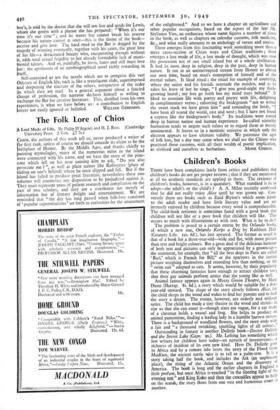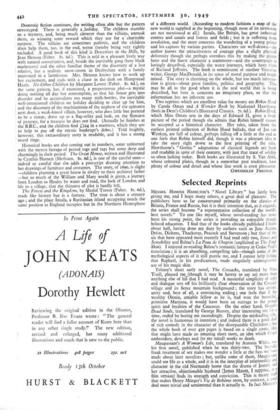Children's Books
THERE have been complaints lately from critics and publishers that children's books do not get proper reviews ; that if they arc mentioned at all no aesthetic standards are applied to them. The reviewer of children's books, however, is in a quandary. What standard is he to adopt—the adult's or the child's ? A. A. Milne recently confessed that he did not really enjoy Alice until he was grown up. Con- versely there are books such as Enid Blyton's which seem jejune to the adult reader and have little literary value and yet are intensely enjoyed by children because every word is comprehensible. The child-book reviewer is sometimes faced with a good book that children will not like or a poor book that children will like. This occurs as much with illustrations as with text. What is he to do ?
The problem is posed to a certain extent by the Orlando books, of which a new one, Orlando Keeps a Dog by Kathleen Hale (Country Life. zos. 6d.), has just apeared. The format as usual is that of a book for a three-year-old—wide and flat, with more picture than text and bright colours. But a great deal of the delicious humour of both text and pictures can only be appreciated by a grown-up— the statement, for example, that "all the best dogs in Paris are called Beel,' which is French for Bill," or the sparrows in the station picture weighing themselves and recording less than nothing, or the "swim suit" adapted to cats. It seems, however, by their popularity that these charming fantasies have enough to attract children too; that their gay animals perform antics that the young like as well. Animal fantasy appears again in Mossy Green Theatre, by Mary Dunn (Harrap. 8s. 6d.), a story which would be suitable for a five- year-old onward. The shape of the story closely follows Alice, for the child sleeps in the wood and wakes to find her parents and to find the story a dream. The events, however, are orderly and without satire. The child has made a tiny theatre in the wood and shrinks in size so that she can enter it—though sizes are vague, for a car made of a chestnut holds a weasel and frog. She helps to produce an animal pantomime, finding a leading lady in a humble harvest mouse. There is a background of woodland flowers, and the story ends with, a fair and " a thousand twinkling, sparkling lights of all colours. Outstanding in fantasy is another Dolittle book—Doctor Dolirtle and the Secret Lake (Cape. 9s.). Mr. Lofting has something which few writers for children have today—an uprush of inventiveness, a richness of incident of its own new kind. Here Dr. Dolittle goes to Africa and by a remote lake hears the story of the Flood from Mudfacc, the ancient turtle who is as tall as a palm-tree. It is a story taking half the book, and includes the Ark (an unpleasant place), the rising of the Atlantic Ocean and the discovery of America. The book is long and the earlier chapters in England a little profuse, but once Africa is 'reached "in the slanting light of the evening sun" and King Koko and then the crocodiles appear to heir on the search, the story flows from one vast and humorous event to another.
Domestic fiction continues, the writing often able but the pattern stereotyped. There is generally a _holiday. The children stumble on a mystery, and, being much cleverer than the villains, unmask them, so winning some reward which they use for a charitable purpose. The villains are sometimes pathetic, and the children Dften help them, too, in the end, terror thereby being very rightly excluded. A good book of this kind is Detectives in the Hills, by Jean Henson (Faber. 8s. 6d.). This is told in a pleasant lively way with natural conversation, and, beside the inevitable gang (here black marketeers) and the other familiar theme of the discovery of a lost relative, has a realistic snow-storm in Derbyshire with a family marooned in a farmhouse. Mrs. Henson knows how to work up her excitement, and ends with a chase in the dark on Hampstead Heath. No Other Children by Margaret Lovett (Faber. 8s. 6d.), on the same pattern, has, if examined, a preposterous plot—a mystic doing nothing all day but contemplate, so that his house gets into disorder and he accumulates too many milk-bottles, the inevitable well-intentioned children on holiday deciding to clear up for him, and the discovery of the machinations of the nephew of the spinsters next door, a weak-kneed villain, however, who does little but pretend to be a statue, dress up as a flag-seller and look, on the flimsiest of pretexts, for a treasure he does not find. (Actually he finishes at the B.B.C., and the children find £224 in a mattress, which they use to help to pay off the mystic bankrupt's debts.) Told brightly, • however, this extraordinary story is readable, and it has a strong moral tinge.
Historical books are also coming out in numbers, some unlearned with the merest farrago of period rags and tags but some deep and charmingly in their period. The Great House, written and illustrated by Cynthia Harnett (Methuen. 8s. 6d.), is one of the careful ones— indeed so careful that she adds a postscript drawing attention to her drawings of furniture and costumes. The story, of 169o, is slight —children planning a great house in rivalry to their architect father —but so much of the William and Mary world is given, a journey from London to Henley by water and road, the look of London and life in a village, that the thinness of plot is hardly felt. The Forest and the Kingdom, by Mcriol Trevor (Faber. 8s. 6d.), reads like history but is a fantasy. The time is about a century ago ; and the place Insula, a Ruritanian island occupying much the same position as England occupies but in the Northern Hemisphere
of a different world. (According to modem fashions a map of the new world is supplied at the beginning, though most of its territories arc not mentioned at all.) Insula, like Britain, has great industrial centres and canals and forests and fields • but it is suffering from revolution, and the story concerns the wandering of a young prince and his capture by various parties. Characters are well-drawn—the author knows the attractiveness of courage plus a slight physical deformity though she perhaps overdoes this by making the prince lame and the finest character a stammerer—and the countryside is lovingly described, especially the water journeys, which have hints of Richard Jefferies. The book is reminiscent of another Victorian writer, George MacDonald, in its sense of moral purpose and magic mixed. The story is charming on the whole, but too much informa- tion is given—about great families, politics and geography. This may be all to the good when it is the real world that is being described, but here is concerns an imaginary place, so that the information has no inherent use.
Two reprints which are excellent value for money are Robin Hood by Carola Oman and A Wonder Book by Nathaniel Hawthorne (both in Dent's Children's Illustrated Classics. 7s. 6d.). Robin Flood, which Miss Oman sets in the days of Edward II, gives a lively picture of the period though she admits that Robin himself cannot be accepted tis a historical character. Her tales, taken from the earliest printed collection of Robin Hood ballads, that of Jan van Wynkyn, are full of colour, perhaps falling off a little at the end as one feels that Robin himself did, though it was a pleasant idea to take the story right down to the first printing of the tales. Hawthorn's " Gothic " adaptations of classical legends are fresh and readable in spite of their century, with just that trace of solidity so often lacking today. Both books are illustrated by S. Van Abbe, whose coloured plates, though in a somewhat past tradition, have plenty of colour and detail and whose line work is even pleasanter.
GWENDOLEN FREEMAN.















































 Previous page
Previous page